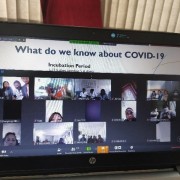Speeches Shim

It’s 2:00 p.m. and Ranita Maibam has just returned from a 10-hour shift caring for people with suspected COVID-19 infections. She has just enough time to tend to her two children, husband, and elderly mother-in-law before she begins her next shift at 9:00 p.m.
Maibam is a Community Health Officer (CHO) at a Health and Wellness Center (HWC) in the northeastern Indian State of Manipur. She is one of thousands of health workers around the country who are working around the clock to contain COVID-19.

The phone lines have been buzzing nonstop and Monica Mishra knows that now is not the time for the water break that she has been wanting to take for the last half an hour. Her ears are red from the headset. But she knows the next caller is more important.
Mishra is one of the tele-counsellors at the “104 Health Helpline” in the state of Madhya Pradesh. The state has a network of tele-counsellors across “104 Helpline,” “108 Emergency Ambulance Helpline” and the “181 Chief Minister’s Helpline,” and currently, the state government requested the tele-counsellors on all three helplines to respond to the emergency situation due to COVID-19.

As reports of the spread of the novel coronavirus began appearing in India, Annie Suchiang had her own fears and apprehensions. She manages the state program for community health workers, known in India as Accredited Social Health Activists (ASHAs), and is in charge of the Comprehensive Primary Healthcare (CPHC) Program in the far northeastern state of Meghalaya. One of her primary concerns was building the capacities of frontline health workers to face COVID-19, the new pandemic the world is still grappling to understand.

“This disease is so dangerous, everyone is getting infected and dying from it and nobody knows how to control it. When people ask me, I have no idea what to answer…”
According to Vineeta Ray, a Community Health Officer (CHO) posted at a Health and Wellness Center (HWC) in Madhya Pradesh India, this was her biggest worry. She had heard that cases were reported in her state but had been given no clear guidance on what she could do. As she is posted in a remote region of the state, she was particularly worried about accessing accurate information quickly. Health and Wellness Centers (HWC), part of the Government of India’s Ayushman Bharat universal health coverage plan, provide comprehensive primary health care services and each HWC serves a population of 5,000 people.

Patil, like most women in her village, provides financial assistance to her family by selling rotis (Indian flat bread) made from a locally grown crop called jowar. But like most households in her village, Patil’s business was regularly disrupted due to an unreliable power supply.

Comment
Make a general inquiry or suggest an improvement.